Blade-Resolved CFD Simulations of a Periodic Array of NREL 5 MW Rotors with and without Towers
Abstract
:1. Introduction
2. Methodology
2.1. Turbine and Domain Geometries
2.2. Meshing
2.3. RANS Setup
2.3.1. AD Simulations
2.3.2. FR Simulations
2.4. DDES Setup
2.5. Postprocessing of URANS Results
3. Results and Discussion
3.1. URANS
3.2. DDES
3.3. Comparison with Theoretical Model
4. Conclusions
Author Contributions
Funding
Institutional Review Board Statement
Informed Consent Statement
Data Availability Statement
Conflicts of Interest
References
- Nishino, T. Two-scale momentum theory for very large wind farms. J. Phys. Conf. Ser. 2016, 753, 32054. [Google Scholar] [CrossRef]
- Wu, Y.T.; Porté-Agel, F. Large-Eddy Simulation of Wind-Turbine Wakes: Evaluation of Turbine Parametrisations. Bound.-Layer Meteorol. 2011, 138, 345–366. [Google Scholar] [CrossRef]
- Naderi, S.; Parvanehmasiha, S.; Torabi, F. Modeling of horizontal axis wind turbine wakes in Horns Rev offshore wind farm using an improved actuator disc model coupled with computational fluid dynamic. Energy Convers. Manag. 2018, 171, 953–968. [Google Scholar] [CrossRef]
- Richmond, M.; Antoniadis, A.; Wang, L.; Kolios, A.; Al-Sanad, S.; Parol, J. Evaluation of an offshore wind farm computational fluid dynamics model against operational site data. Ocean Eng. 2019, 193, 106579. [Google Scholar] [CrossRef]
- Stevens, R.J.; Martínez-Tossas, L.A.; Meneveau, C. Comparison of wind farm large eddy simulations using actuator disk and actuator line models with wind tunnel experiments. Renew. Energy 2017, 116, 470–478. [Google Scholar] [CrossRef]
- Sørensen, J.N.; Mikkelsen, R.F.; Henningson, D.S.; Ivanell, S.; Sarmast, S.; Andersen, S.J. Simulation of wind turbine wakes using the actuator line technique. Phil. Trans. R. Soc. 2015, 373, 20140071. [Google Scholar] [CrossRef] [Green Version]
- Kalvig, S.; Manger, E.; Hjertager, B. Comparing different CFD wind turbine modelling approaches with wind tunnel measurements. J. Phys. Conf. Ser. 2014, 555, 012056. [Google Scholar] [CrossRef] [Green Version]
- Madsen, M.H.A.; Zahle, F.; Sørensen, N.N.; Martins, J.R.R.A. Multipoint high-fidelity CFD- based aerodynamic shape optimization of a 10 MW wind turbine. Wind Energ. Sci. 2019, 4, 163–192. [Google Scholar] [CrossRef] [Green Version]
- Rodrigues, R.V.; Lengsfeld, C. Development of a Computational System to Improve Wind Farm Layout, Part I: Model Validation and Near Wake Analysis. Energies 2019, 12, 940. [Google Scholar] [CrossRef] [Green Version]
- Stergiannis, N.; Lacor, C.; Beeck, J.V.; Donnelly, R. CFD modelling approaches against single wind turbine wake measurements using RANS. J. Phys. Conf. Ser. 2016, 753, 032062. [Google Scholar] [CrossRef]
- Uchida, T.; Taniyama, Y.; Fukatani, Y.; Nakano, M.; Bai, Z.; Yoshida, T.; Inui, M. A New Wind Turbine CFD Modeling Method Based on a Porous Disk Approach for Practical Wind Farm Design. Energies 2020, 13, 3197. [Google Scholar] [CrossRef]
- Weihing, P.; Schulz, C.; Lutz, T.; Krämer, E. Comparison of the Actuator Line Model with Fully Resolved Simulations in Complex Environmental Conditions. J. Phys. Conf. Ser. 2017, 854, 012049. [Google Scholar] [CrossRef]
- Miao, W.; Li, C.; Pavesi, G.; Yang, J.; Xie, X. Investigation of wake characteristics of a yawed HAWT and its impactson the inline downstream wind turbine using unsteady CFD. J. Wind. Eng. Ind. Aerodyn. 2017, 168, 60–71. [Google Scholar] [CrossRef]
- Wilson, J.M.; Davis, C.J.; Venayagamoorthy, S.K.; Heyliger, P.R. Comparisons of Horizontal-Axis Wind Turbine Wake Interaction Models. J. Sol. Energ. Eng. 2015, 137, 031001. [Google Scholar] [CrossRef]
- Zahle, F.; Sørensen, N.N.; Johansen, J. Wind Turbine Rotor-Tower Interaction Using an Incompressible Overset Grid Method. Wind Energy 2009, 12, 594–619. [Google Scholar] [CrossRef]
- Hand, M.M.; Simms, D.A.; Fingersh, L.J.; Jager, D.W.; Cotrell, J.R.; Schreck, S.; Larwood, S.M. Unsteady Aerodynamics Experiment Phase VI: Wind Tunnel Test Configurations and Available Data Campaigns. Tech. Rep. 2001, 15000240. [Google Scholar] [CrossRef] [Green Version]
- Rodrigues, R.V.; Lengsfeld, C. Development of a Computational System to Improve Wind Farm Layout, Part II: Wind Turbine Wakes Interaction. Energies 2019, 12, 1328. [Google Scholar] [CrossRef] [Green Version]
- Schepers, J.G.; Boorsma, K.; Cho, T.; Gomez-Iradi, S.; Schaffarczyk, P.; Jeromin, A.; Shen, W.Z.; Lutz, T.; Meister, K.; Stoevesandt, B. Final Report of IEA Task 29, Mexnet (Phase 1): Analysis of Mexico Wind Tunnel Measurements; Technical University of Denmark: Lyngby, Denmark, 2012. [Google Scholar]
- Delafin, P.-L.; Nishino, T. Momentum balance in a fully developed boundary layer over a staggered array of NREL 5MW rotors. J. Phys. Conf. Ser. 2017, 854, 12009. [Google Scholar] [CrossRef] [Green Version]
- Jonkman, J.; Butterfield, S.; Musial, W.; Scoot, G. Definition of a 5-MW Reference Wind Turbine for Offshore System Development. Tech. Rep. 2009, 947422. [Google Scholar] [CrossRef] [Green Version]
- Resor, B.R. Definition of a 5MW/61.5m wind turbine blade reference model. Tech. Rep. 2013, 1095962. [Google Scholar] [CrossRef] [Green Version]
- Ma, L.; Nishino, T.; Antoniadis, A. Prediction of the impact of support structures on the aerodynamic performance of large wind farms. J. Renew. Sustain. Energy 2019, 11, 063306. [Google Scholar] [CrossRef]
- Nishino, T.; Dunstan, T.D. Two-scale momentum theory for time-dependent modelling of large wind farms. J. Fluid Mech. 2020, 894, A2. [Google Scholar] [CrossRef]
- Bazilevs, Y.; Hsu, M.-C.; Akkerman, I.; Wright, S.; Takizawa, K.; Henicke, B.; Spielman, T.; Tezduyar, T.E. 3D simulation of wind turbine rotors at full scale. Part I: Geometry modeling and aerodynamics. Int. J. Numer. Meth. Fluids 2011, 65, 207–235. [Google Scholar] [CrossRef] [Green Version]
- Major, D.; Palacios, J.; Maufhumer, M.; Schmitz, S. A Numerical Model for the Analysis of Leading-Edge Protection Tapes for Wind Turbine Blades. J. Phys. Conf. Ser. 2020, 1452, 12058. [Google Scholar] [CrossRef] [Green Version]
- ANSYS Inc. ANSYS Fluent User’s Guide Release 17.2; ANSYS Inc.: Canonsburg, PA, USA, 2016. [Google Scholar]
- Menter, F.R. Two-Equation Eddy-Viscosity Turbulence Models for Engineering Applications. AIAA J. 1994, 32, 1598–1605. [Google Scholar] [CrossRef] [Green Version]
- Blocken, B.; Stathopoulos, T.; Carmeliet, J. CFD simulation of the atmospheric boundary layer: Wall function problems. Atmos. Environ. 2007, 41, 238–252. [Google Scholar] [CrossRef]
- Bleeg, J.; Purcell, M.; Ruisi, R.; Traiger, E. Wind farm blockage and the consequences of neglecting its impact on energy production. Energies 2018, 11, 1609. [Google Scholar] [CrossRef] [Green Version]
- Patel, K.; Dunstan, T.D.; Nishino, T. Time-dependent upper limits to the performance of large wind farms due to mesoscale atmospheric response. Energies 2021, 14, 6437. [Google Scholar] [CrossRef]
- Pinto, M.L.; Franzini, G.R.; Simos, A.S. A CFD analysis of NREL’s 5MW wind turbine in full and model scales. J. Ocean Eng. Mar. Energy 2020, 6, 211–220. [Google Scholar] [CrossRef]
- Vijayakumar, G.; Brasseur, J.G.; Lavely, A.; Jayaraman, B. Interaction of Atmospheric Turbulence with Blade Boundary Layer Dynamics on a 5MW Wind Turbine using Blade-boundary-layer-resolved CFD with hybrid URANS-LES. In Proceedings of the 34th Wind Energy Symposium, AIAA SciTech Forum, San Diego, CA, USA, 4–8 January 2016. [Google Scholar] [CrossRef]
- Eitel-Amor, G.; Flores, O.; Schlatter, P. Hairpin vortices in turbulent boundary layers. Phys. Fluids 2015, 27, 025108. [Google Scholar] [CrossRef]
- Nishino, T.; Hunter, W. Tuning turbine rotor design for very large wind farms. Proc. R. Soc. A 2018, 474, 237. [Google Scholar] [CrossRef] [Green Version]
- Ma, L.; Nishino, T. Preliminary estimate of the impact of support structures on the aerodynamic performance of very large wind farms. J. Phys. Conf. Ser. 2018, 1037, 72036. [Google Scholar] [CrossRef]



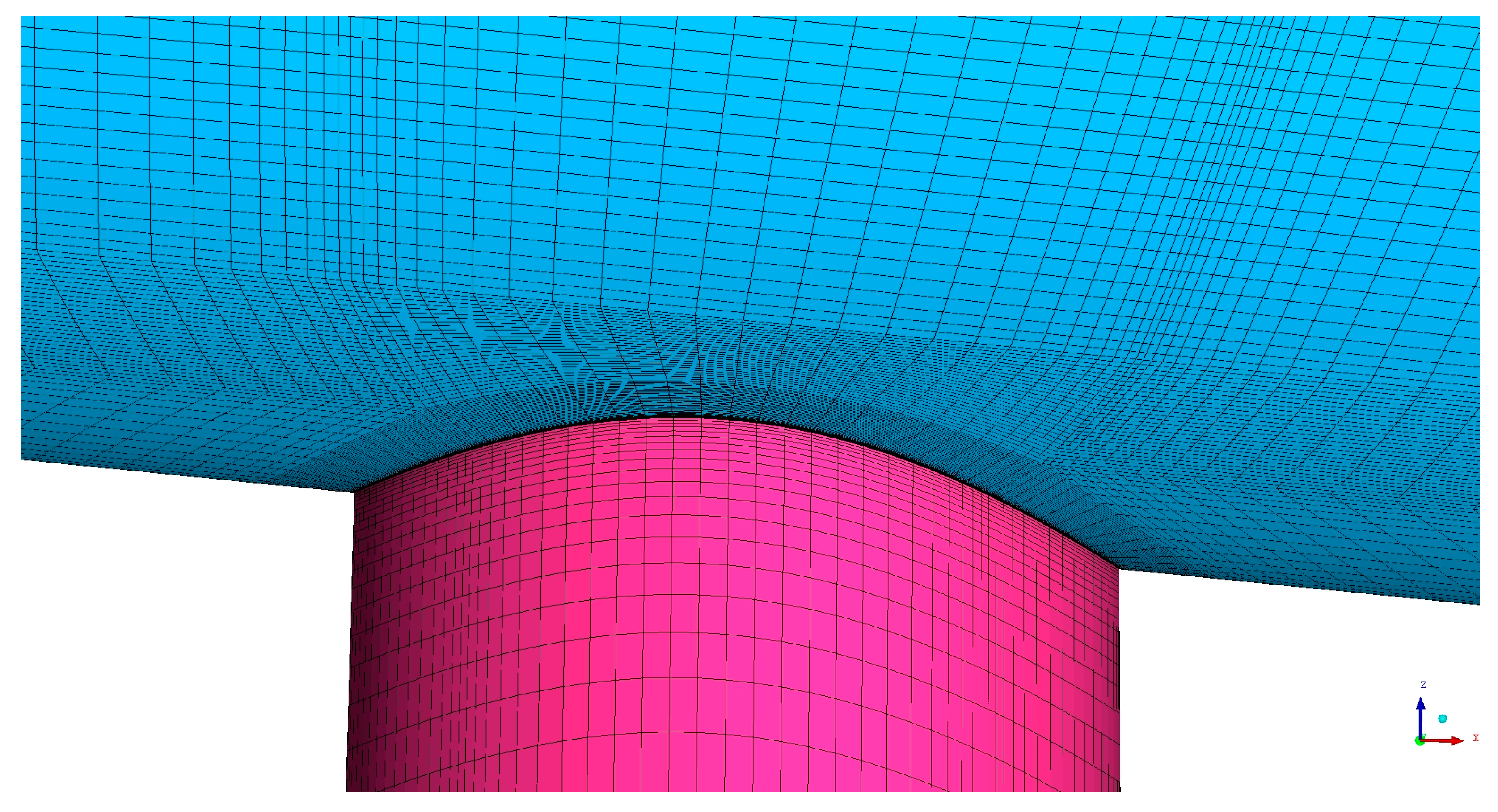
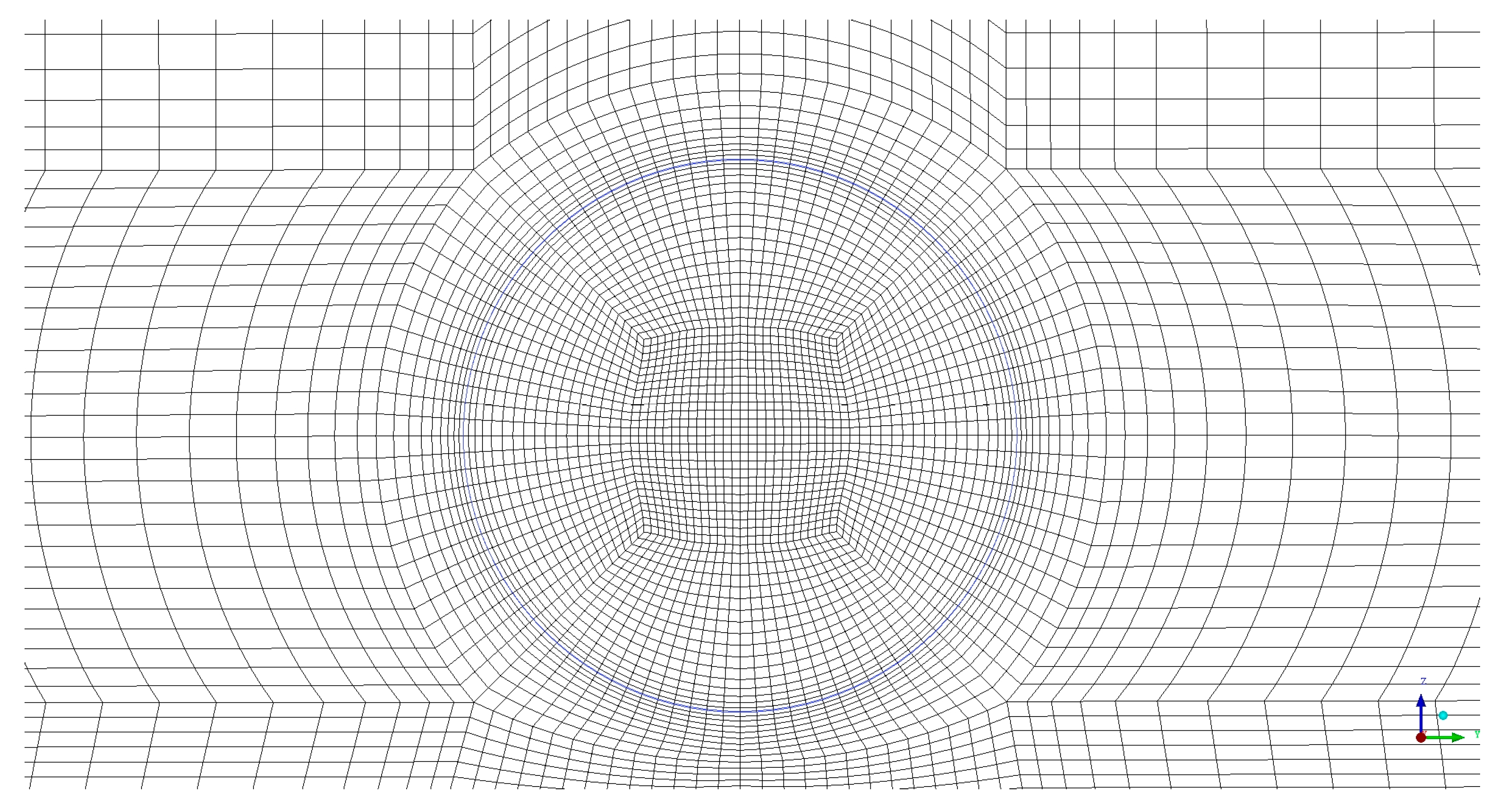
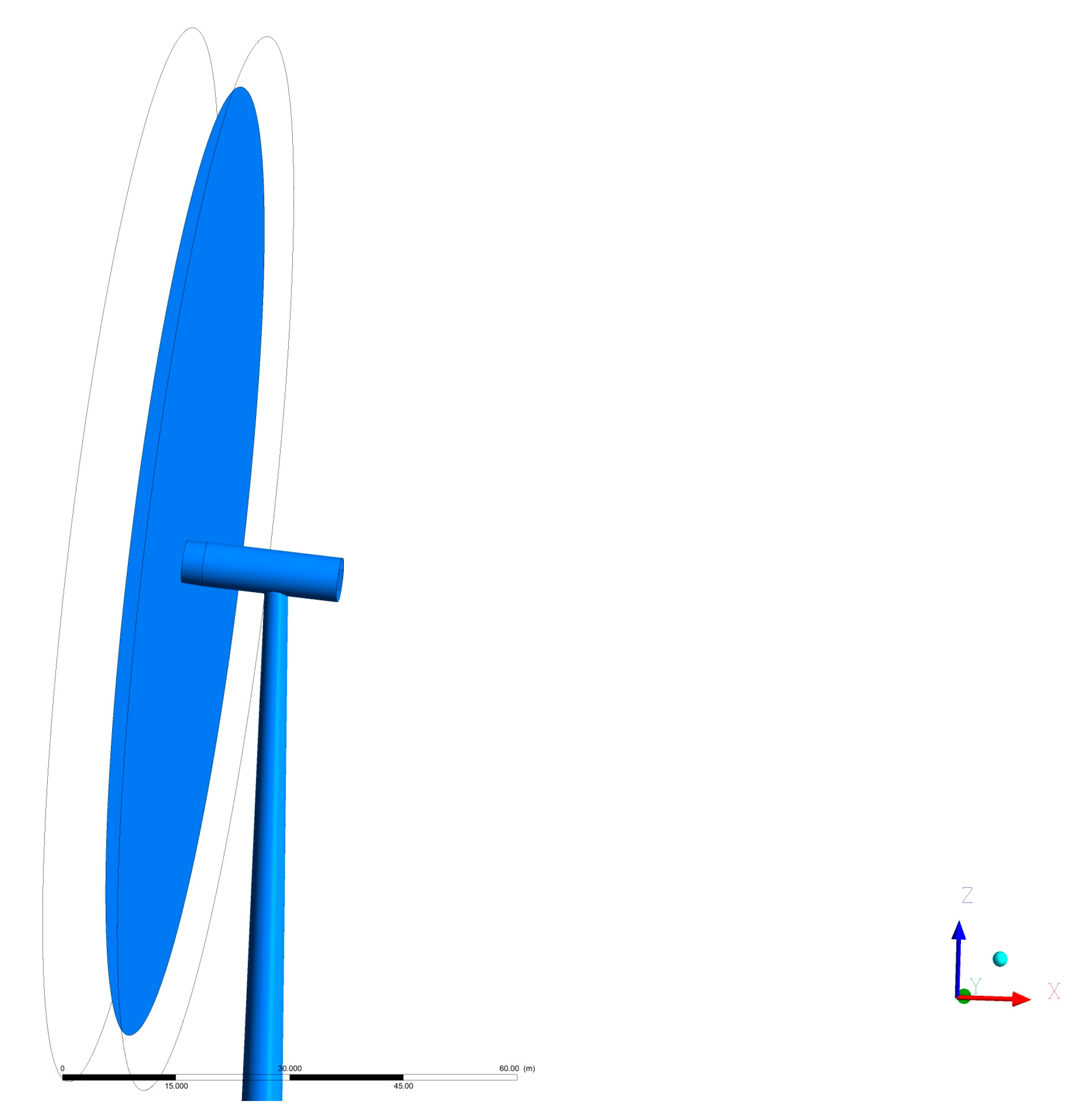
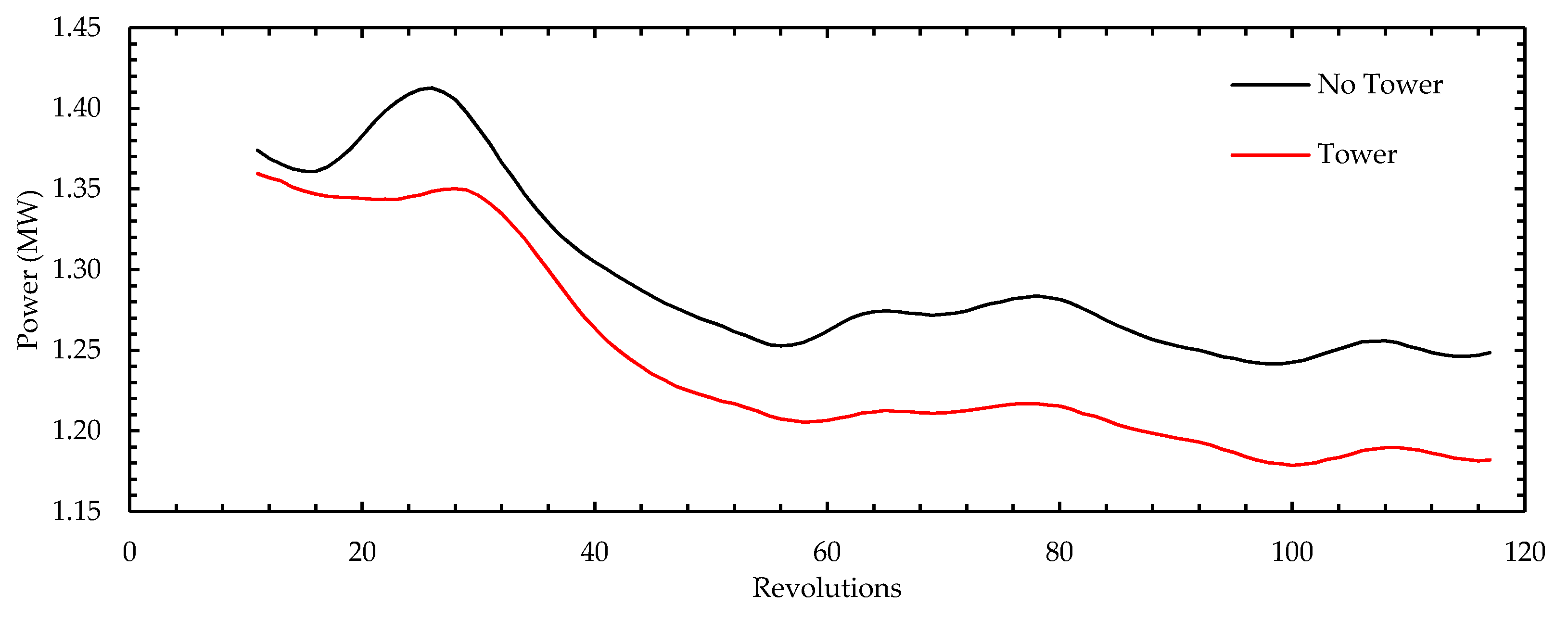
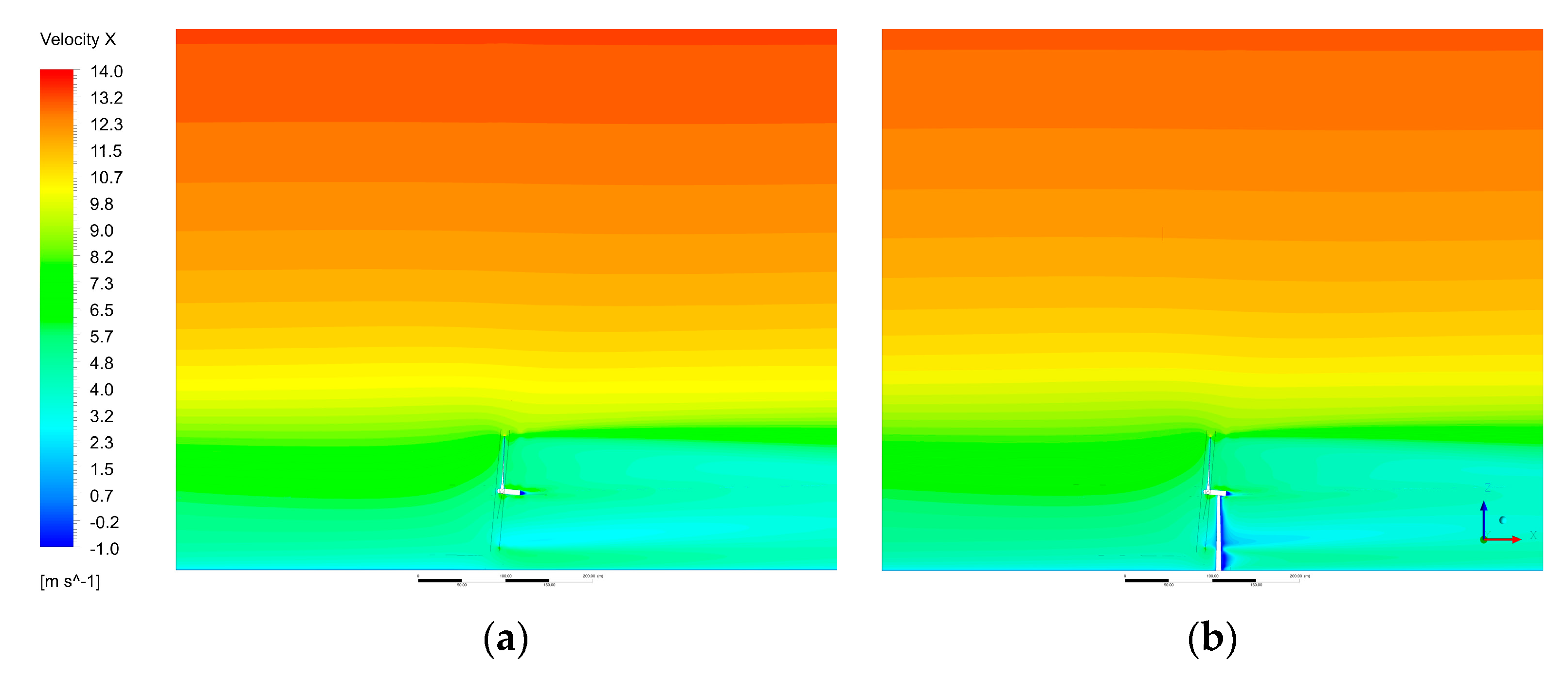
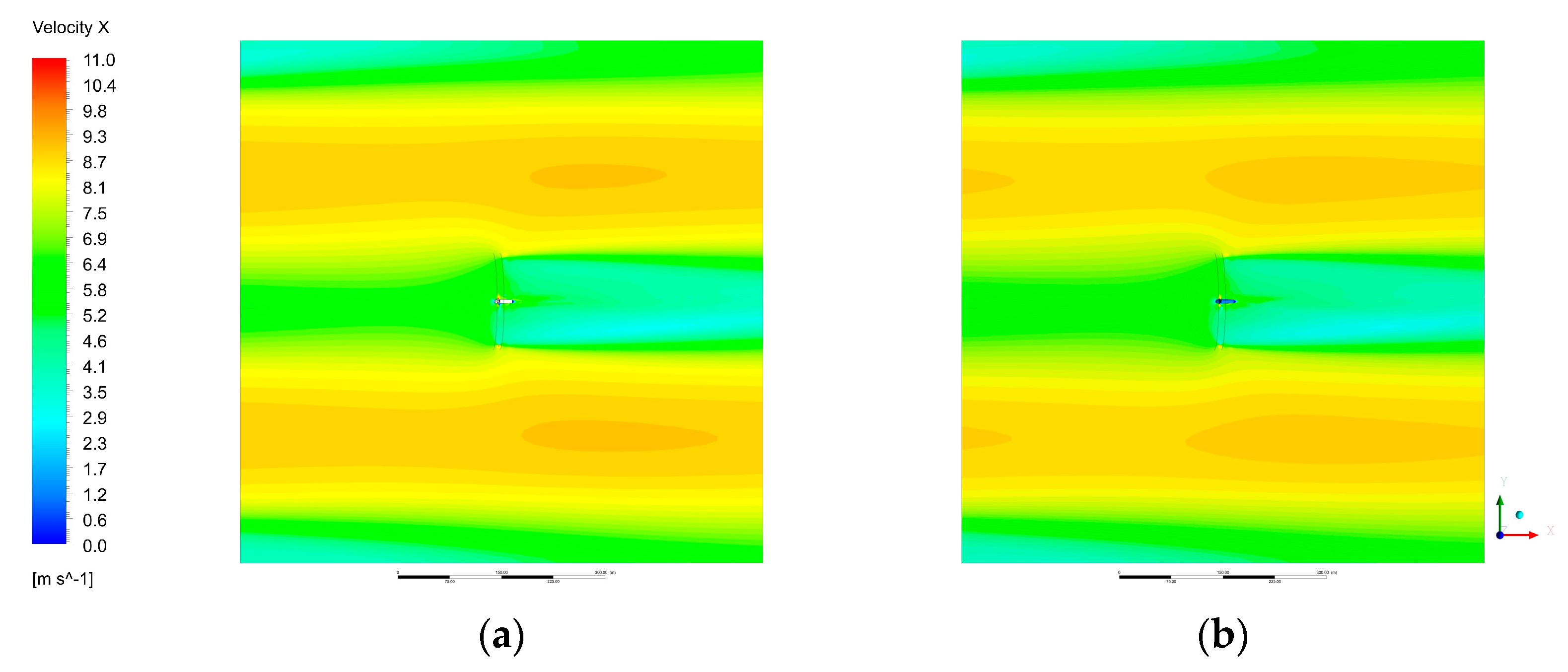


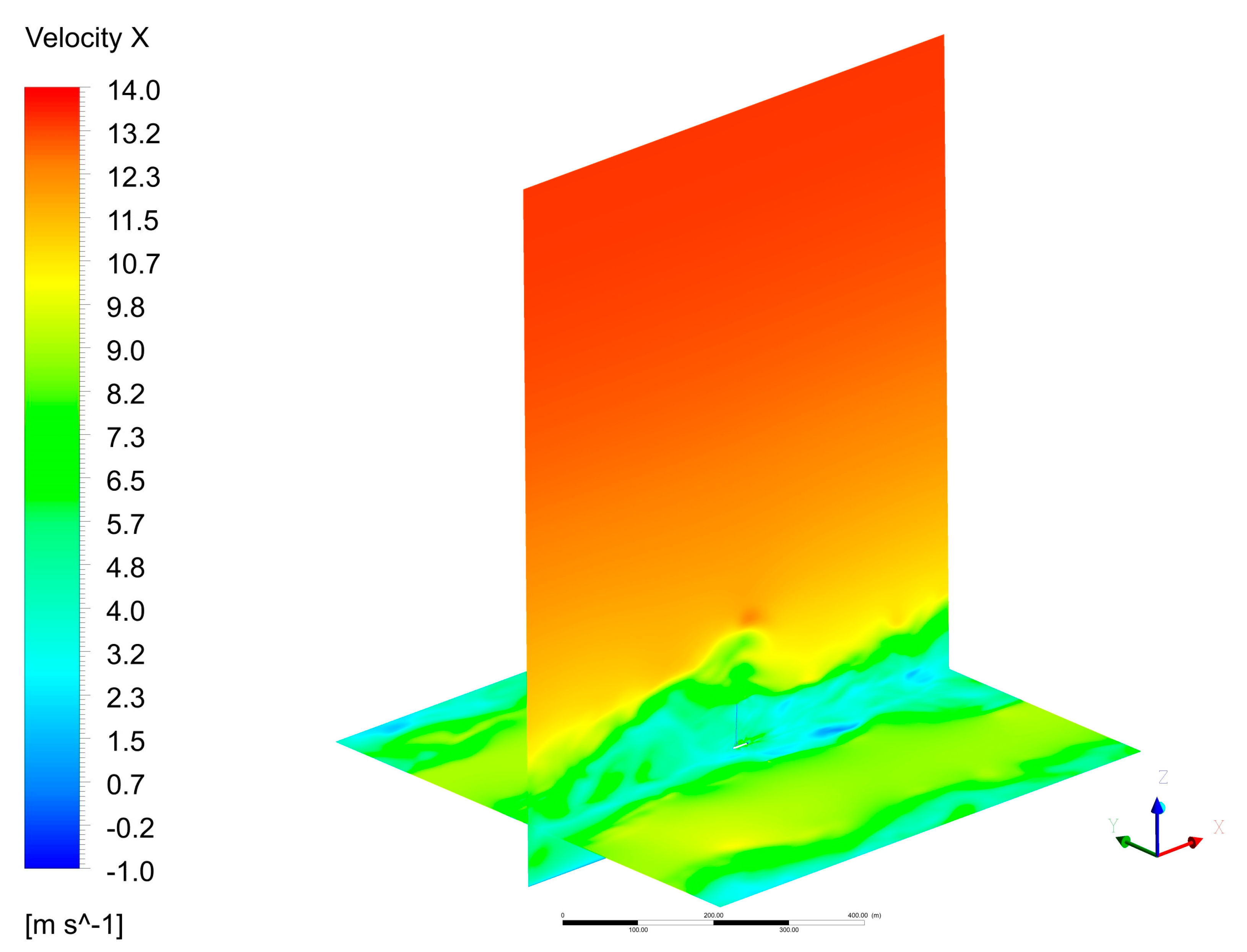
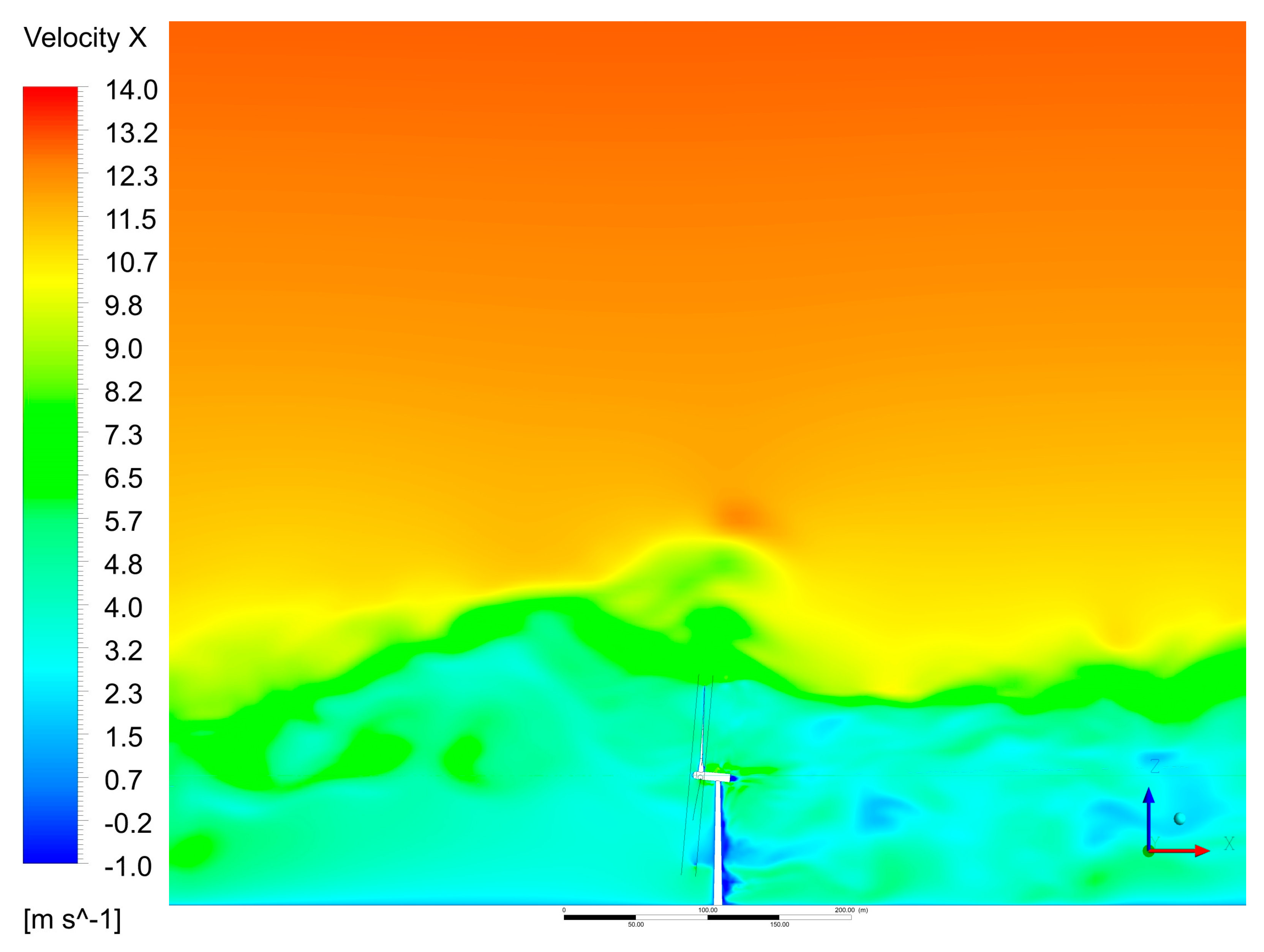
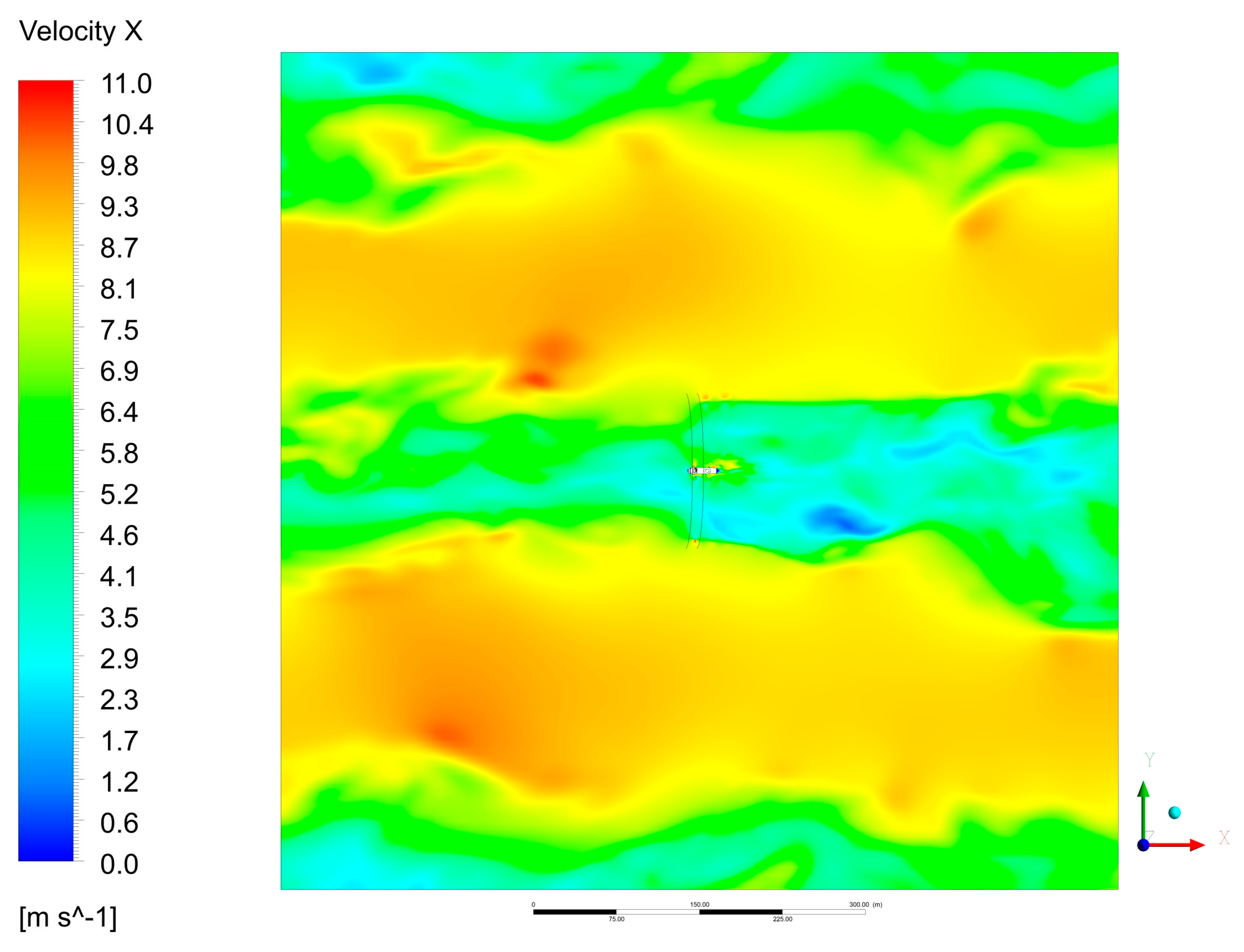
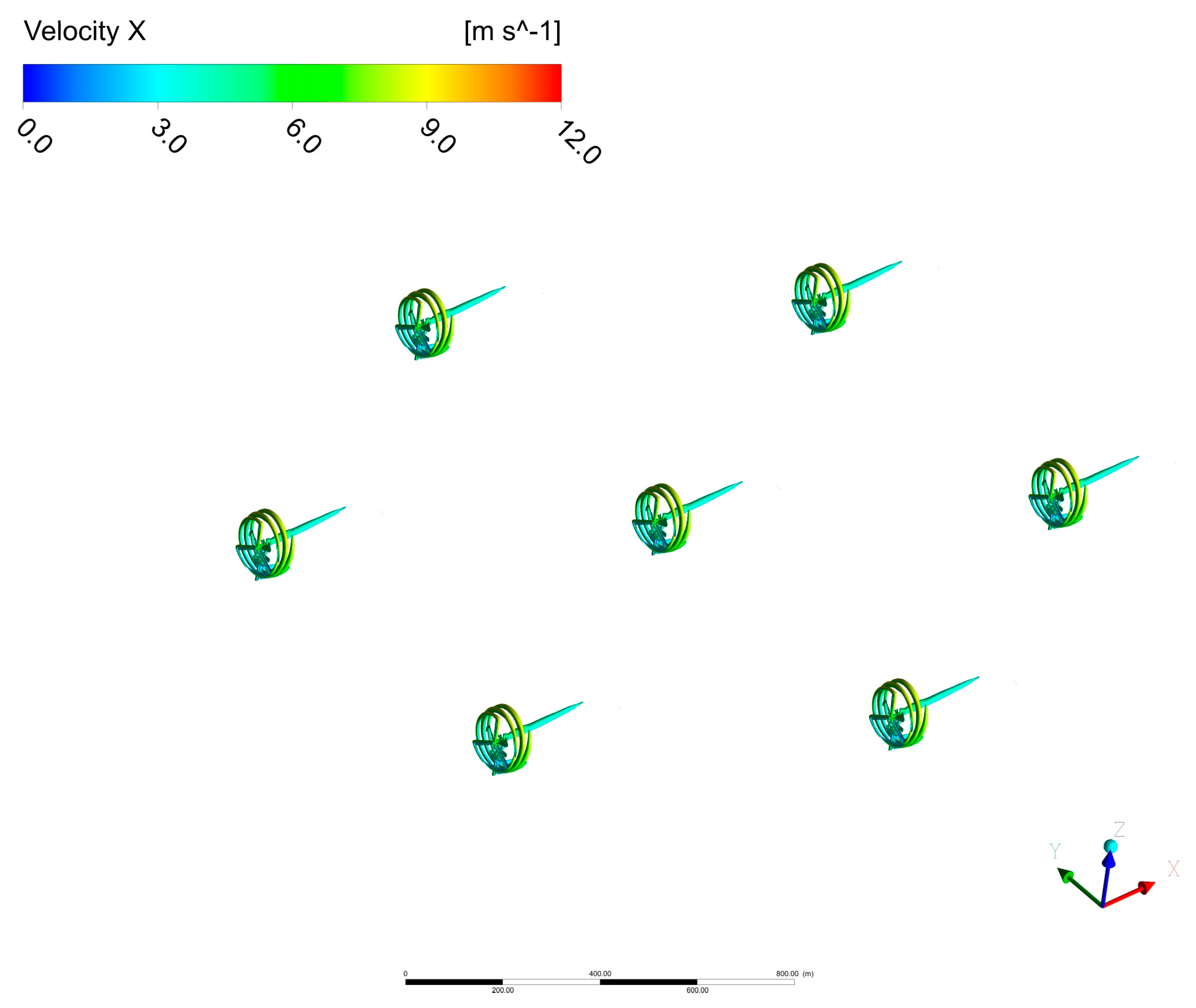
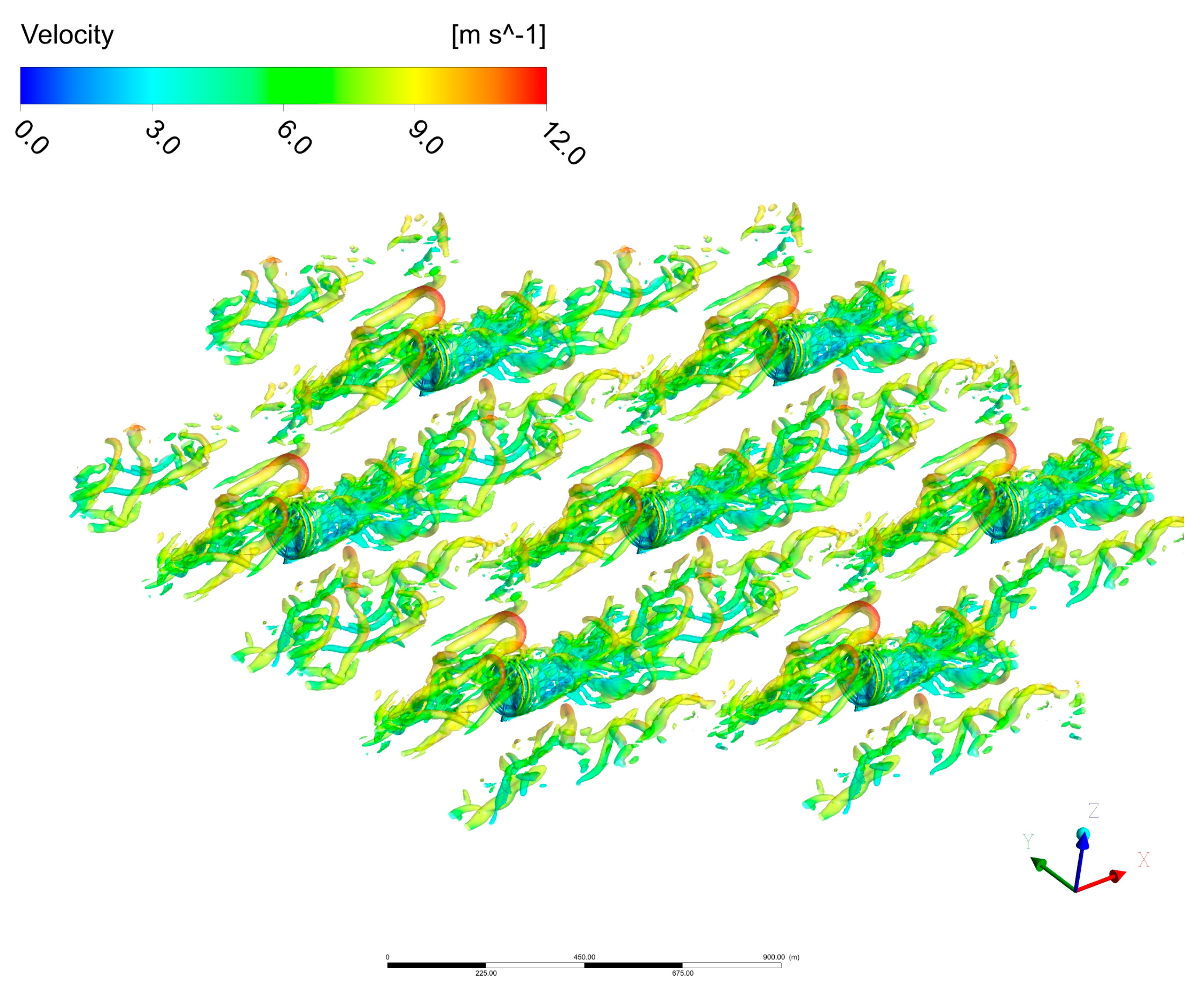
| FR + Tower | FR | AD + Tower | AD | |
|---|---|---|---|---|
| Rotor subdomain | N/A | |||
| Outer domain | N/A | |||
| Total |
| AD-RANS | No Tower | 0.0651 | 0.414 | 0.176 | 0.603 |
| Tower | 0.0641 | 0.412 | 0.174 | 0.601 | |
| Diff.% | 1.55% | 0.52% | 1.04% | 0.35% | |
| FR-URANS | No Tower | 0.0495 | 0.303 | 0.167 | 0.561 |
| Tower | 0.0469 | 0.306 | 0.163 | 0.570 | |
| Diff.% | 5.21% | −0.90% | 2.48% | −1.67% | |
| Theoretical model [22] | No Tower | 0.0622 | 0.380 | 0.198 | 0.570 |
| Tower | 0.0607 | 0.380 | 0.195 | 0.570 | |
| Diff.% | 2.50% | 0.00% | 1.68% | 0.00% |
Publisher’s Note: MDPI stays neutral with regard to jurisdictional claims in published maps and institutional affiliations. |
© 2022 by the authors. Licensee MDPI, Basel, Switzerland. This article is an open access article distributed under the terms and conditions of the Creative Commons Attribution (CC BY) license (https://creativecommons.org/licenses/by/4.0/).
Share and Cite
Ma, L.; Delafin, P.-L.; Tsoutsanis, P.; Antoniadis, A.; Nishino, T. Blade-Resolved CFD Simulations of a Periodic Array of NREL 5 MW Rotors with and without Towers. Wind 2022, 2, 51-67. https://doi.org/10.3390/wind2010004
Ma L, Delafin P-L, Tsoutsanis P, Antoniadis A, Nishino T. Blade-Resolved CFD Simulations of a Periodic Array of NREL 5 MW Rotors with and without Towers. Wind. 2022; 2(1):51-67. https://doi.org/10.3390/wind2010004
Chicago/Turabian StyleMa, Lun, Pierre-Luc Delafin, Panagiotis Tsoutsanis, Antonis Antoniadis, and Takafumi Nishino. 2022. "Blade-Resolved CFD Simulations of a Periodic Array of NREL 5 MW Rotors with and without Towers" Wind 2, no. 1: 51-67. https://doi.org/10.3390/wind2010004
APA StyleMa, L., Delafin, P.-L., Tsoutsanis, P., Antoniadis, A., & Nishino, T. (2022). Blade-Resolved CFD Simulations of a Periodic Array of NREL 5 MW Rotors with and without Towers. Wind, 2(1), 51-67. https://doi.org/10.3390/wind2010004







